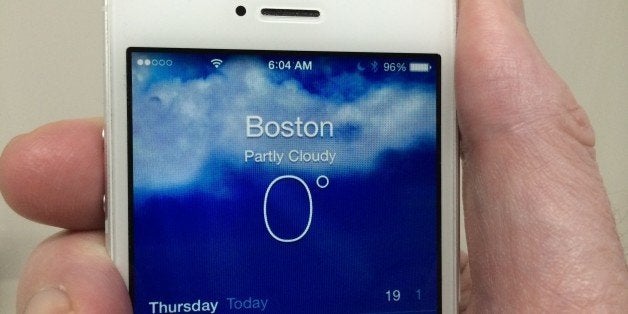
It’s 20 degrees out and your smartphone rings. If you want to answer it but don't want to take off your toasty warm gloves, we have a few hacks to help.
The reason your gloves prevent you from using your touchscreen is that they block the electric charge transmitted via the moisture in your fingertips, explains Jacob Wobbrock, a professor at the University of Washington's Information School. The capacitive touchscreen -- the lingo for this charge-sensitive feature -- needs that moisture so it can detect exactly where your finger is on the screen.
But when you have gloves on, Wobbrock told The Huffington Post, you can trick your phone into thinking it's being touched by fingertips. All you need is a bit of moisture and some contact.
Here's what to do:
1. Use your nose.
With this method, your nose acts just as your finger would. Wobbrock, who's also the co-founder and CEO of Seattle tech company AnswerDash, calls this trick a “good everyday way” to answer your smartphone without removing your gloves.
Downsides: It can be a little tricky and requires a somewhat dexterous nose, as well as the ability to go cross-eyed. You might get a few weird looks, too. Plus, there's a high chance for smearing snot on your phone. Ew.
Watch HuffPost Sports Editor Maxwell Strachan effortlessly demonstrate this technique here:
2. Breathe on your phone or lick your gloves.
This technique uses your saliva or the condensation from your breath to provide the moisture that would normally come from your fingertips but gets blocked when you wear gloves. The user simply licks a gloved fingertip before swiping, or breathes on the phone and swipes the screen as soon as possible. Wobbrock said a knit glove is ideal for the latter because “water molecules from [your] breath on the screen kind of find their way into those little gaps and crevices and create a bridge from your finger to the screen.”
Downsides: The breathing technique, as attempted by HuffPost, was inconsistent, especially in very cold or windy conditions. Licking the glove is more reliable, but it will leave the aftertaste of glove in your mouth and, well, it's kinda gross.
Here’s the author successfully using this technique:
3. Use a meat stick.
We'll admit that we were pretty skeptical when we first stumbled across this technique, which apparently became popular in South Korea. But it it works like a charm. The grease in the meat stick provides the conductivity needed for the screen to recognize it, even in sub-zero temperatures.
Downsides: In order for this to work reliably, you have to have a meat stick with you at all times. Then you become known as the person who has a meat stick with them at all times. While delicious, frequent consumption of meat sticks could also cause health problems.
Here’s Associate Business Editor Alexander Kaufman demonstrating how casual this technique is when done right:
4. Buy smartphone gloves.
Smartphone gloves don’t need the moisture described in the previous techniques because conductive thread is sewn into the fingertips, allowing your smartphone to recognize when it’s being touched, Wobbrock said.
Downsides: You have to buy special gloves (or make your own). And for some reason you'll never seem to have them on when your phone rings.
Tech Editor Alexis Kleinman shows how easy it is to answer your phone when you do remember to wear your smartphone gloves:
It should be noted, however, that Apple does not recommend using your iPhone in temperatures below 32 degrees Fahrenheit. Cold temperatures are also known to negatively affect other brands of phone as well.
But Wobbrock says manufacturers and developers are looking into ways to improve the experience of using phones in extreme temperatures.
Progress is already being made to allow users to answer their phones via voice commands or pre-approved gestures. Wobbrock says more advanced gestures will provide a way for users to get around “situational impairments” -- cold weather, heat or physical disabilities -- that hinder smartphone use. iPhones, for example, already allow users to shake their phones in order to undo actions.
For now, though, keep your meat stick handy.
